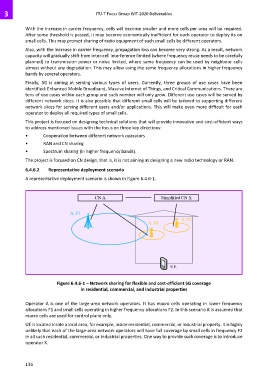Page 142 - ITU-T Focus Group IMT-2020 Deliverables
P. 142
3 ITU-T Focus Group IMT-2020 Deliverables
With the increase in carrier frequency, cells will become smaller and more cells per area will be required.
After some threshold is passed, it may become economically inefficient for each operator to deploy its on
small cells. This may prompt sharing of radio equipment of such small cells by different operators.
Also, with the increase in carrier frequency, propagation loss can become very strong. As a result, network
capacity will gradually shift from inter-cell interference limited (where frequency reuse needs to be carefully
planned) to transmission power or noise limited, where same frequency can be used by neighbour cells
almost without any degradation. This may allow using the same frequency allocations in higher frequency
bands by several operators.
Finally, 5G is aiming at serving various types of users. Currently, three groups of use cases have been
identified: Enhanced Mobile Broadband, Massive Internet of Things, and Critical Communications. There are
tens of use cases within each group and such number will only grow. Different use cases will be served by
different network slices. It is also possible that different small cells will be tailored to supporting different
network slices for serving different users and/or applications. This will make even more difficult for each
operator to deploy all required types of small cells.
This project is focused on designing technical solutions that will provide innovative and cost-efficient ways
to address mentioned issues with the focus on three key directions:
• Cooperation between different network operators
• RAN and CN sharing
• Spectrum sharing (in higher frequency bands).
The project is focused on CN design, that is, it is not aiming at designing a new radio technology or RAN.
6.4.6.2 Representative deployment scenario
A representative deployment scenario is shown in Figure 6.4.6-1.
CN A Simplified CN X
A, F1
X, F2
A, F2
UE
Figure 6.4.6-1 – Network sharing for flexible and cost-efficient 5G coverage
in residential, commercial, and industrial properties
Operator A is one of the large-area network operators. It has macro cells operating in lower frequency
allocations F1 and small cells operating in higher frequency allocations F2. In this scenario it is assumed that
macro cells are used for control plane only.
UE is located inside a local area, for example, inside residential, commercial, or industrial property. It is highly
unlikely that each of the large-area network operators will have full coverage by small cells in frequency F2
in all such residential, commercial, or industrial properties. One way to provide such coverage is to introduce
operator X.
136

